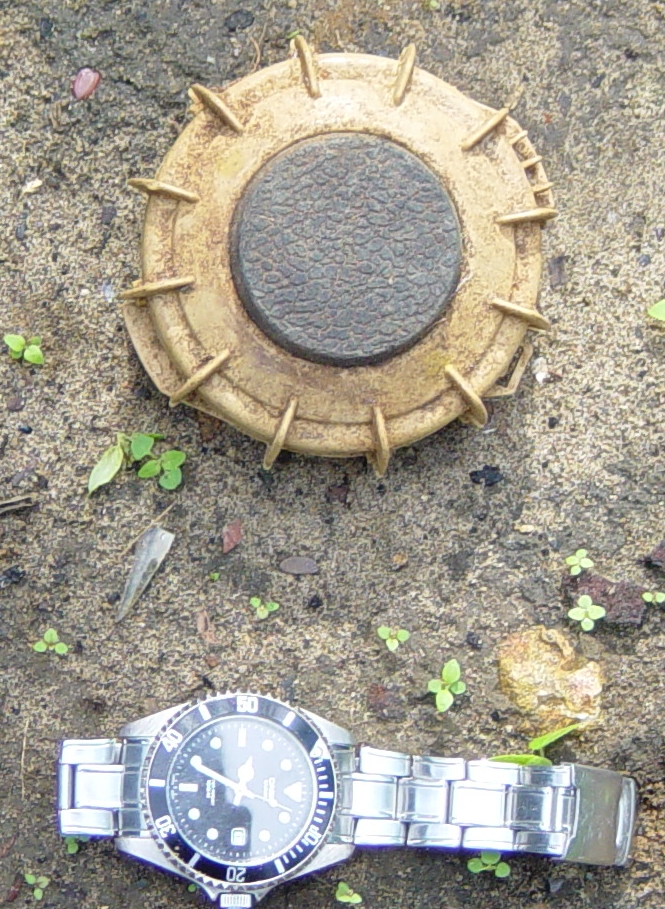|
P-40 APPLE Mine
The P-40 mine is a Vietnamese anti-personnel fragmentation stake mine. The mines were produced using the spherical steel cases of United States BLU-24/B and BLU-66 submunitions on top of which is a plastic adaptor to accept an MUV style tripwire fuze. The spherical steel case is grooved to aid fragmentation, with the grooves either being internal or external depending on the variant of submunition used as the basis of the mine. The mine is normally mounted on a small three pronged stake and has an effective radius of around 10 meters. The mine is found in Cambodia and Vietnam. Specifications * Diameter: 70 mm * Height: 104 mm * Weight: 0.614 kg * Explosive content: 0.12 kg of TNT Trinitrotoluene (), more commonly known as TNT, more specifically 2,4,6-trinitrotoluene, and by its preferred IUPAC name 2-methyl-1,3,5-trinitrobenzene, is a chemical compound with the formula C6H2(NO2)3CH3. TNT is occasionally used as a reagen ... References * ''Jane's Mines and ... [...More Info...] [...Related Items...] OR: [Wikipedia] [Google] [Baidu] |
Anti-personnel Mine
Anti-personnel mines are a form of mine designed for use against humans, as opposed to anti-tank mines, which are designed for use against vehicles. Anti-personnel mines may be classified into blast mines or fragmentation mines; the latter may or may not be a bounding mine. The mines are often designed to injure, not kill, their victims to increase the logistical (mostly medical) support required by enemy forces that encounter them. Some types of anti-personnel mines can also damage the tracks on armoured vehicles or the tires of wheeled vehicles. The International Campaign to Ban Landmines has sought to ban mines culminating in the 1997 Ottawa Treaty, although this treaty has not yet been accepted by over 30 countries. Use Anti-personnel mines are used in a similar manner to anti-tank mines, in static "mine fields" along national borders or in defense of strategic positions as described in greater detail in the land mine article. What makes them different from most anti-ta ... [...More Info...] [...Related Items...] OR: [Wikipedia] [Google] [Baidu] |
Cambodia
Cambodia (; also Kampuchea ; km, កម្ពុជា, UNGEGN: ), officially the Kingdom of Cambodia, is a country located in the southern portion of the Indochinese Peninsula in Southeast Asia, spanning an area of , bordered by Thailand to the northwest, Laos to the north, Vietnam to the east, and the Gulf of Thailand to the southwest. The capital and largest city is Phnom Penh. The sovereign state of Cambodia has a population of over 17 million. Buddhism is enshrined in the constitution as the official state religion, and is practised by more than 97% of the population. Cambodia's minority groups include Vietnamese, Chinese, Chams and 30 hill tribes. Cambodia has a tropical monsoon climate of two seasons, and the country is made up of a central floodplain around the Tonlé Sap lake and Mekong Delta, surrounded by mountainous regions. The capital and largest city is Phnom Penh, the political, economic and cultural centre of Cambodia. The kingdom is an elective co ... [...More Info...] [...Related Items...] OR: [Wikipedia] [Google] [Baidu] |
TNT (explosive)
Trinitrotoluene (), more commonly known as TNT, more specifically 2,4,6-trinitrotoluene, and by its preferred IUPAC name 2-methyl-1,3,5-trinitrobenzene, is a chemical compound with the formula C6H2(NO2)3CH3. TNT is occasionally used as a reagent in chemical synthesis, but it is best known as an explosive material with convenient handling properties. The explosive yield of TNT is considered to be the standard comparative convention of bombs and asteroid impacts. In chemistry, TNT is used to generate charge transfer salts. History TNT was first prepared in 1863 by German chemist Julius Wilbrand and originally used as a yellow dye. Its potential as an explosive was not recognized for three decades, mainly because it was too difficult to detonate because it was less sensitive than alternatives. Its explosive properties were first discovered in 1891 by another German chemist, Carl Häussermann. TNT can be safely poured when liquid into shell cases, and is so insensitive that in ... [...More Info...] [...Related Items...] OR: [Wikipedia] [Google] [Baidu] |

